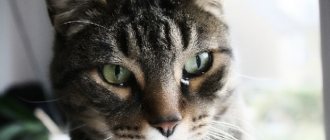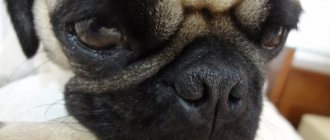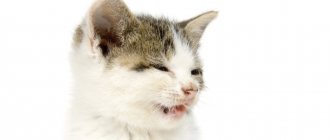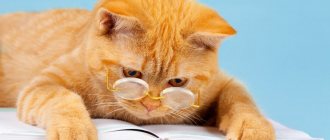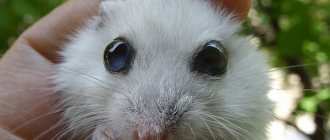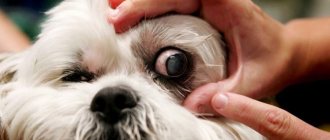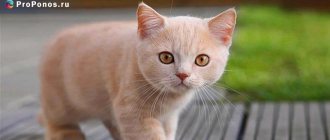Why do my eyes water?
There are physiological and pathological lacrimation. The first refers to the accumulation of a small amount of dried tear fluid in the corners of the eyes. It looks like brown or brown-brown crusts. Occurs for a number of reasons:
- Age.
In small kittens, in the first days of life, the organs of vision are still closed. When they erupt, tears flow profusely, which is considered a natural process and lasts no longer than a week. To prevent infection, it is recommended to rinse your pet's eyes with warm, clean water. - Hair getting into the eye.
Often found in long-haired breeds. - Irritation.
When dust, tobacco smoke and some other substances come into contact with the mucous membranes of the eyes. - Predisposition.
A similar sign is often found in Scottish, British, Persian and some other breeds. - Dry air.
- Dream.
The release of a small amount of tears after sleep is considered normal.
In all of the above cases, the pet’s health remains normal. No hygienic or therapeutic procedures are required.
Pathological lacrimation is observed in almost any eye disease. The animal experiences noticeable discomfort and may sneeze, squint and rub its eyes with its paws.
Here is a list of the most common reasons:
- Neoplasms of the eyeball.
- Parasitic infection. Discharge appears due to intoxication of the body.
- Pathologies of the internal structures of the eye.
- Fungal infection.
- Cataract or glaucoma.
- Blepharitis (inflammation of the eyelids).
- Allergic reaction (mainly to household chemicals).
- Conjunctivitis is an inflammation of the outer layer of the eye.
- Keratitis is an inflammation of the cornea, which is accompanied by clouding and ulceration.
- Corneal injuries.
- Increased production of tear fluid.
- Anomalies in the development of visual organs.
- Obstruction of the nasolacrimal duct. The fur around the eyes turns brownish (so-called “tear tracks” are formed). Often found in cats of certain breeds (British, Persian, Sphynx and others).
- Entropion of a cat's eyelid. It bends in the other direction, the mucous membrane is irritated by hair and eyelashes.
- Chemical and thermal burns.
- Entry of a foreign body.
- Viral respiratory diseases (calicivirus or herpesvirus infections). At first the discharge is clear and mucous, but later becomes purulent. Other characteristic symptoms are also present: poor appetite, lethargy, nasal discharge, sneezing.
Cat's eyes are watery: causes and treatment
Reasons why a cat's eyes water:
- with a foreign body in the eyes . It could be some kind of speck, fluff, twig, midge, and possibly dirt. If you find something like this, the first thing you should do is rinse the animal’s eyes under running water. Once the foreign object has been washed, apply 1% tetracycline ointment to the cat's upper eyelid . It would be a good idea to show the animal to a veterinarian.
- Weakening of the immune system . This is possible if the kitten is taken away from its mother too early. But only a veterinarian can find out whether this is so. He will also develop a regimen for taking the necessary medications and adjust the animal’s diet.
- The presence of allergies , which, just like people, are inherent in cats. Allergens can be the same as for humans: dust, chemicals, pollen, etc. Here, consultation with a specialist is also necessary, since it is unlikely that the owner himself will be able to accurately determine both the allergy itself and the cause of its occurrence.
- Worms . This is a very common cause of watery eyes in cats. To exclude such a cause, the animal should be regularly treated for worms.
- Breed cats. There are several breeds that have a characteristic skull structure with a flattened nose and deformed nasolacrimal ducts. Only daily eye rinsing and special attention to hygiene in these risky areas will help.
Prone to watery eyes - Colds . If the cat also sneezes and coughs, sleeps most of the time and absorbs a lot of water, there is reason to suspect a cold . You should not treat the animal yourself; it is better to contact a veterinarian.
- Feline distemper is accompanied, in addition to discharge from the eyes, often with pus, high fever, diarrhea and vomiting, and general weakness. Self-treatment is unacceptable.
What breeds may have eye problems?
Eye problems can occur in different cats. However, some breeds suffer from this the most:
- Persian cats;
- Scots;
- British.
One of the reasons lies in long hair falling on the mucous membrane, which causes irritation and tearing. In Persian and exotic breeds there is no talk of the disease in this case, it is a physiological feature. The structure of the organ of vision causes inconvenience to the animal. The eyes begin to periodically hurt, change color, yellow or dark discharge appears, and the bridge of the nose may swell. At the same time, cats do not refuse food and are active at home and outside.
Symptoms
The pathological nature of lacrimation can be determined by several signs. The following symptoms are usually present:
- asymmetry of the pupils;
- swelling and redness of the eyes;
- excessive sunken or bulging eyeball;
- purulent discharge;
- change in iris color;
- irritated cornea;
- the formation of a painful crust or cloudy film on the visual organs;
- presence of injuries (bruises, scratches, bleeding);
- the animal squints;
- photophobia (the cat hides in the dark corners of the apartment).
Purulent discharge from a cat's eyes
How to treat
Depending on the cause of lacrimation, the veterinarian selects the appropriate treatment method. It takes into account the pet’s age, its health status and some other factors.
For conjunctivitis, the eyes are washed with solutions with an antiseptic effect (for example, Furacilin 0.2%). If the process is caused by a bacterial infection, then Levomycetin, Kanamycin, Sofradex drops are used.
For severe swelling, use a solution of hydrocortisone and novocaine.
If lacrimation is allergic in nature, then it is advisable to prescribe antihistamines and corticosteroids. In addition, you need to find and eliminate the irritant.
Other commonly used medications:
- "Tsiprovet";
- Levomycetin ointment;
- "Diamond Eyes";
- "Anandin";
- drops "Bars";
- tetracycline ointment;
- solution of 2% boric acid.
Antibiotics should always be used with caution as they may cause adverse reactions. Antibiotic ointments are applied 3 times a day.
Before removing a foreign body, the cat is given an anesthetic injection to facilitate its removal. Next, armed with a cotton pad and tweezers, they carry out a manipulation to remove the object.
As an addition to the main treatment, you can use traditional medicine recipes. The following products are used to wash and treat the area around the eyes:
- Decoctions of medicinal herbs (chamomile, sage, St. John's wort, calendula). They even eliminate purulent discharge.
- Green tea. Has a calming and anti-inflammatory effect.
- A weakly concentrated solution of potassium permanganate. Has a good antibacterial effect.
- Strongly brewed black tea. Has a pronounced anti-inflammatory effect.
Treatment at home (medicines and folk remedies)
Quite often, after determining the reasons for the appearance of tears in a cat, its owners do not have enough time or funds to provide assistance to their pet in a veterinary clinic. In this case, such assistance can be provided to the animal at home. It is generally accepted that any antiseptic solutions are suitable for this. Furacilin is used as a 0.2% agent.
If the cause of conjunctivitis is a bacteria, then the following will be useful:
- sofradex,
- chloramphenicol or
- kanamycin.
Any of these drugs are instilled 5 times a day
per animal in each eye
.
If you have an ointment that contains antibiotics (the most popular is tetracycline ointment), it should be applied three times a day
.
If there is significant swelling in the eye area, the cat suffers from pain, and here novocaine or hydrocortisone will help.
If the cause of lacrimation is a foreign body in the eye, then anesthesia with an injection is required to remove the foreign object. When the pain subsides a little and the animal calms down, you need to take tweezers, a cotton swab, roll the eyelid outward and try to extract the cause of the lacrimation.
From folk remedies
To wash the sore eyes of cats with lacrimation, use a decoction of chamomile, St. John's wort, calendula or sage. Also, lotions with infused black tea are quite effective.
How to properly instill eye drops
When you contact a doctor because your cat is drooling and his eyes are watery, the owner of the animal receives recommendations for treatment. Among the drugs prescribed are drops that are used constantly.
The effectiveness of therapy and the psychological state of the animal depend on how carefully and painlessly the medicine is dripped into the swollen eye of a furry pet.
Attention! When purchasing drops, you need to check the expiration date and integrity of the packaging. The use of expired medicine will, at best, be ineffective in combating the disease, and at worst, it will be dangerous for the mucous membranes.
The instillation process can be carried out independently or with the help of a partner. It is necessary to follow the sequence of manipulations:
- Place your pet on your lap. The cat should not see drugs and auxiliary attributes. You can cover it with a diaper so that it does not scratch the owner during the procedure.
- Fix your head with your hand on top and wipe your eyes and the area around them with a damp cotton swab. It can be moistened either with plain boiled water (not hot) or with a solution of furatsilin.
- Use your fingers to widen the eyelid as much as possible.
- Introduce 1-2 drops of the drug into the lower, slightly open part of the eye, without touching the surface with the tip of the bottle, without making sudden movements.
- Hold your pet on your lap for about 3 minutes. This is necessary to prevent the animal from wiping its muzzle with its paws or rubbing it against other surfaces.
- Apply drops to the right (left) eye using the same principle.
Using the same manipulations, you can apply ointment to the eyelid. In this case, the animal is not allowed to open its eyes so that the medicine is absorbed.
The drugs can pinch and irritate the mucous membrane, causing it to turn pink. If after treatment one eye of a cat waters and she squints, this does not affect the quality of therapy and does not harm the pet.
Attention! If, a few hours after treatment, the cat scratches and squints its eyes, keeps them closed, drools, coughs, and wheezes, this may mean that the drug has caused an allergy.
Tearing as a symptom
The first and surest sign of the presence of the disease is the presence of color in the tears that come out. However, even if a cat has clear, watery eyes, it is still worth taking it to the vet if the following symptoms occur:
- Faded or changed eye color;
- Inadequate reaction of the pupil to light or its absence;
- Changes in the shape of the eyeball, the occurrence of asymmetry of the eyeballs or pupils;
- Inflammation appeared, expressed by swelling, redness, swelling, suppuration;
- The presence of any visible injury.
How to wipe and rinse a cat's eyes
If a cat's eye often waters, the owner should know what to do first. Veterinarians recommend cleaning mucous membranes from pus and other secretions with special solutions. This method is suitable for treating sour eyes in breeds prone to allergies (Bengal, Fold, Sphynx, etc.), as well as in kittens at birth.
For this, use black tea, chamomile decoction, infusion of St. John's wort, calendula, sage or furatsilin solution. The products not only disinfect the surface, but also have a calming effect and relieve swelling.
For processing you will need:
- selected antiseptic;
- a piece of bandage or cotton pads;
- pipette (can be replaced with a small syringe for vaccinations without a needle);
- handkerchief (napkin).
Attention! Before the procedure, you must wash your hands with soap. Sterilize the pipette after use.
Wiping process:
- Take the animal on your lap and create calm conditions.
- Generously moisten one swab in the medicinal solution or apply it to the problem area using a pipette.
- Wait for the brown crust to soften. With a small influx, it is enough to hold the solution for a few seconds.
- Wipe the eyelid with clean discs soaked in antiseptic, removing dirt.
- Moisten a new swab and use it to treat the area near the eye, as well as snot on the surface of the nose, if any.
- Wipe with a dry cloth.
The second cloudy vision should be treated after the cat has calmed down. You can let her run around and rest. Cleansing is carried out according to the same principle. Only clean disks are used so as not to spread the infection.
When a cat's eye is watering, it is important to know what to do after cleaning the surface of the eyelid. If the veterinarian has not prescribed medication, but the mucous membrane continues to become inflamed and the eyelid continues to swell, additional treatment will be required.
What to put in and rinse if your cat’s eyes are watering:
- 2% boric acid solution;
- 0.02% solution of furatsilin;
- 0.01% chlorhexidine;
- 9% saline solution.
Advice. Before washing, it is necessary to monitor the concentration of the drug. The use of an increased dose leads to a burn of the mucous membrane.
You can purchase ready-made solutions at a veterinary pharmacy:
- "Bars" with novocaine, furatsilin;
- “Diamond Eyes” with chlorocide C, taurine, chlorhexidine.
Using a pipette, drop the required amount of solution into both eyes, constantly wiping off any leaking liquid. At the same time, the cat can blink and close its eyelids. Redness on the mucous membrane is normal.
Complications, consequences and prognosis
Watery eyes can be caused not only by your pet being exposed to the wind or allergies. This could be a case of trauma. For example, when a cat's eye is bloody and watery. If the organs of vision are clouded, the presence of discharge on the mucous membrane, vomiting, diarrhea, we can talk about an intestinal infection. Home remedies are not enough in this situation. How quickly your pet can be treated depends on its health, as well as the ability to preserve its vision.
Without treatment, the infection will spread to other areas of the face. As a result, swelling appears, the iris changes color, the black pupil becomes covered with a white film, and the eye becomes opaque. This leads to loss of vision. The nose often stops breathing, the animal looks skinny, lethargic, sneezes, eats and drinks poorly.
Therefore, if discharge appears, you should not treat your cat yourself, especially an old one. It is important to seek professional help immediately.
The kitten's eyes are watery: normal or pathological
In the first month of life, babies' eyes constantly water, and this is not a disease, but a physiological feature of development. Moisture washes away dust particles, as well as pathogens, while the immune system is not sufficiently developed.
Minor clear discharge after sleep is a common occurrence. However, when lacrimation is constant, you should be wary.
Excessive lacrimation is called epiphora. A characteristic symptom is a tear track on the face. The secretion spreads over the cheeks, dries out, oxidizes, and acquires a reddish-brown color. Wool falls out in areas of constant wetting. The British and Persians are predisposed to such a development of events. The situation requires contacting a veterinarian.
Eye injury, external irritants, cigarette smoke, and pollen cause allergies. In this case, the discharge is transparent. The exudate dries out and sticks the eyelids together. The kitten tears them apart with its paws and introduces opportunistic microflora. Inflammation develops.
The discharge thickens and turns yellow or green. When there is a high degree of intestinal infestation or chlamydia infection, the eyes turn red. In the latter case, first one organ of vision becomes inflamed, then the other.
Be sure to read:
What to do if your cat is sneezing, watery or purulent eyes, causes
Conjunctivitis is a symptom of dangerous infectious diseases - calcivirosis, rhinotracheitis, panleukopenia, toxoplasmosis.
The kitten's eye is festering and watery
With improper treatment or its absence, serous conjunctivitis, regardless of the cause, turns into catarrhal, and then purulent. If the kitten is not vaccinated, contact a veterinarian. Otherwise, specialized drops are used.
If there are no positive results, seek professional help. The owner's frivolous behavior results in loss of vision in the pet.
In some cases, the eye does not close and a red spot is visible in the middle. This is an inflammation of the nictitating membrane - the third eyelid. In most cases, the predisposition to pathologies is congenital. The eye stops closing, waters, and itches. Rubbing the itchy area with your paws aggravates the situation. In most cases, surgery is required to correct the problem.
The kitten's eyes are watery after eating
Pet lovers are concerned about the tears that the baby produces after eating. After satiation, the kittens' eyes well up with tears. Most often, owners of small Scots complain about the phenomenon. It is possible that there is a congenital anomaly.
Cat lovers change food and with each new diet they note an increase in the volume of eye fluid. In this case, an adaptive response to a change in diet is possible. For most pets, the phenomenon goes away on its own. Most likely, excessive lacrimation after feeding is a hereditary individual developmental feature.
Kitten sneezes and watery eyes
If the kitten was not vaccinated on time, or for some reason there was a breakthrough in immunity, infectious pathologies develop.
High mortality is characterized by panleukopenia, as well as a group of listed diseases called cat flu:
- Calicivirus;
- Herpes (Rhinotracheitis);
- Bordetellosis;
- Chlamydia.
Symptoms resemble those of human flu. If treated improperly or not, the disease leads to loss of vision or death of the pet. The combination of conjunctivitis and rhinitis, the presence of ulcers on the cornea and mucous membrane of the mouth is a serious symptom that requires immediate seeking veterinary help.
Be sure to read:
The cat has red eyes: normal or pathological, symptoms, causes of inflammation, first aid, treatment
The kitten's brown eyes are watering
Copious tear secretions (epiphora) become brown as they dry out and oxidize in the air. There is a breed predisposition.
Short-faced pets - British, Persians, and Scots - suffer. Brown crusts are, first of all, a cosmetic defect and a harbinger of incipient baldness due to maceration of the skin.
Prevention
There are a number of preventive measures that can help reduce the risk of tearing in cats. List of recommendations:
- timely vaccination;
- systematic deworming;
- maintaining an optimal level of humidity in the room;
- compliance with the rules of hygienic care (treatment of the visual organs, combing hair, bathing);
- establishing a proper diet with sufficient vitamins and microelements;
- regular trimming of nails (to prevent accidental injury to the eyes).
You should never treat a cat without first consulting a specialist. This can lead to negative consequences for the pet's health.
